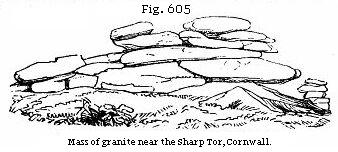
The Student’s Elements of Geology
General Aspect of Plutonic Rocks. — Granite and its Varieties. — Decomposing into Spherical Masses. — Rude columnar Structure. — Graphic Granite. — Mutual Penetration of Crystals of Quartz and Feldspar. — Glass Cavities in Quartz of Granite. — Porphyritic, talcose, and syenitic Granite. — Schorlrock and Eurite. — Syenite. — Connection of the Granites and Syenites with the Volcanic Rocks. — Analogy in Composition of Trachyte and Granite. — Granite Veins in Glen Tilt, Cape of Good Hope, and Cornwall. — Metalliferous Veins in Strata near their Junction with Granite. — Quartz Veins. — Exposure of Plutonic Rocks at the surface due to Denudation.
The Plutonic rocks may be treated of next in order, as they are most nearly allied to the volcanic class already considered. I have described, in the first chapter, these Plutonic rocks as the unstratified division of the crystalline or hypogene formations, and have stated that they differ from the volcanic rocks, not only by their more crystalline texture, but also by the absence of tuffs and breccias, which are the products of eruptions at the earth’s surface, whether thrown up into the air or the sea. They differ also by the absence of pores or cellular cavities, to which the expansion of the entangled gases gives rise in ordinary lava, never being scoriaceous or amygdaloidal, and never forming a porphyry with an uncrystalline base, nor alternating with tuffs.
From these and other peculiarities it has been inferred that the granites have been formed at considerable depths in the earth, and have cooled and crystallised slowly under great pressure, where the contained gases could not expand. The volcanic rocks, on the contrary, although they also have risen up from below, have cooled from a melted state more rapidly upon or near the surface. From this hypothesis of the great depth at which the granites originated, has been derived the name of “Plutonic rocks.” The beginner will easily conceive that the influence of subterranean heat may extend downward from the crater of every active volcano to a great depth below, perhaps several miles or leagues, and the effects which are produced deep in the bowels of the earth may, or rather must, be distinct; so that volcanic and Plutonic rocks, each different in texture, and sometimes even in composition, may originate simultaneously, the one at the
surface, the other far beneath it. The Plutonic formations also agree with the volcanic in having veins or ramifications proceeding from central masses into the adjoining rocks, and causing alterations in these last, which will be presently described. They also resemble trap in containing no organic remains; but they differ in being more uniform in texture, whole mountain masses of indefinite extent appearing to have originated under conditions precisely similar.
The two principal members of the Plutonic family of rocks are Granite and Syenite, each of which, with their varieties, bear very much the same relation to each other as the trachytes bear to the basalts. Granite is a compound of feldspar, quartz, and mica, the feldspars being rich in silica, which forms from 60 to 70 per cent of the whole aggregate. In Syenite quartz is rare or wanting, hornblende taking the place of mica, and the proportion of silica not exceeding 50 to 60 per cent.

Granite and its Varieties.—Granite often preserves a very uniform character throughout a wide range of territory, forming hills of a peculiar rounded form, usually clad with a scanty vegetation. The surface of the rock is for the most part in a crumbling state, and the hills are often surmounted by piles of stones like the remains of a stratified mass, as in Figure 605, and sometimes like heaps of boulders, for which they have been mistaken. The exterior of these stones, originally quadrangular, acquires a rounded form by the action of air and water, for the edges and angles waste away more rapidly than the sides. A similar spherical structure has already been described as characteristic of basalt and other volcanic formations, and it must be referred to analogous causes, as yet but imperfectly understood. Although it is the general peculiarity of granite to assume no definite shapes, it is nevertheless occasionally subdivided by fissures, so as to assume a cuboidal, and even a columnar, structure. Examples of these appearances may be seen near the Land’s End, in Cornwall. (See Fig. 606.)

Feldspar, quartz, and mica are usually considered as the minerals essential to granite, the feldspar being most abundant in quantity, and the proportion of quartz exceeding that of mica. These minerals are united in what is termed a confused crystallisation; that is to say, there is no regular arrangement of the crystals in granite, as in gneiss (see Fig. 622), except in the variety termed graphic granite, which occurs mostly in granitic veins. This variety is a compound of feldspar and quartz, so arranged as to produce an imperfect laminar structure. The crystals of feldspar appear to have been first formed, leaving between them the space now occupied by the darker-coloured quartz. This mineral, when a section is made at right angles to the alternate plates of feldspar and quartz, presents broken lines, which have been compared to Hebrew characters. (See Fig. 608.) The variety of granite called by the French Pegmatite, which is a mixture of quartz and common feldspar, usually with some small admixture of white silvery mica, often passes into graphic granite.
Ordinary granite, as well as syenite and eurite, usually contains two kinds of feldspar: First, the common, or orthoclase, in which potash is the prevailing alkali, and this
generally occurs in large crystals of a white or flesh colour; and secondly, feldspar in smaller crystals, in which soda predominates, usually of a dead white or spotted, and striated like albite, but not the same in composition.*

As a general rule, quartz, in a compact or amorphous state, forms a vitreous mass, serving as the base in which feldspar and mica have crystallised; for although these minerals are much more fusible than silex, they have often imprinted their shapes upon the quartz. This fact, apparently so paradoxical, has given rise to much ingenious speculation. We should naturally have anticipated that, during the cooling of the mass, the flinty portion would be the first to consolidate; and that the different varieties of feldspar, as well as garnets and tourmalines, being more easily liquefied by heat, would be the last. Precisely the reverse has taken place in the passage of most granite aggregates from a fluid to a solid state, crystals of the more fusible minerals being found enveloped in hard, transparent, glassy quartz, which has often taken very faithful casts of each, so as to preserve even the microscopically minute striations on the surface of prisms of tourmaline. Various explanations of this phenomenon have been proposed by MM. de Beaumont, Fournet, and Durocher. They refer to M. Gaudin’s experiments on the fusion of quartz, which show that silex, as it cools, has the property of remaining in a viscous state, whereas alumina never does. This “gelatinous flint” is supposed to retain a considerable degree of plasticity long after the granitic mixture has acquired a low temperature. Occasionally we find the quartz and feldspar mutually imprinting their forms on each other, affording evidence of the simultaneous crystallisation of both.†
* Delesse, Ann. des Mines, 1852, tome iii, p. 409, and 1848, tome xiii, p. 675.
† Bulletin, 2e série, iv, 1304; and D’Archiac, Hist. des Progrès de la Géol., i, 38.
According to the experiments and observations of Gustavus Rose, the quartz of granite has the specific gravity of 2·6, which characterises silica when it is precipitated from a liquid solvent, and not that inferior density, namely, 2·3, which belongs to it when it cools in the laboratory from a state of fusion in what is called the dry way. By some it had been rashly inferred that the manner in which the consolidation of granite takes place is exceedingly different from the cooling of lavas, and that the intense heat supposed to be necessary for the production of mountain masses of Plutonic rocks might be dispensed with. But Mr. David Forbes informs me that silica can crystallise in the dry way, and he has found in quartz forming a constituent part of some trachytes, both from Guadeloupe and Iceland, glass cavities quite similar to those met with in genuine volcanic minerals.
These “glass cavities,” which with many other kindred phenomena have been carefully studied by Mr. Sorby, are those in which a liquid, on cooling, has become first viscous and then solid without crystallising or undergoing a definite change in its physical structure. Other cavities which, like those just mentioned, are frequently discernible under the microscope in the minerals composing granitic rocks, are filled, some of them with gas or vapour, others with liquid, and by the movements of the bubbles thus included the distinctness of such cavities from those filled with a glassy substance can be tested. Mr. Sorby admits that the frequent occurrence of fluid cavities in the quartz of granite implies that water was almost always present in the formation of this rock; but the same may be said of almost all lavas, and it is now more than forty years since Mr. Scrope insisted on the important part which water plays in volcanic eruptions, being so intimately mixed up with the materials of the lava that he supposed it to aid in giving mobility to the fluid mass. It is well known that steam escapes for months, sometimes for years, from the cavities of lava when it is cooling and consolidating. As to the result of Mr. Sorby’s experiments and speculations on this difficult subject, they may be stated in a few words. He concludes that the physical conditions under which the volcanic and granitic rocks originate are so far similar that in both cases they combine igneous fusion, aqueous solution, and gaseous sublimation--the proof, he says, of the operation of water in the formation of granite being quite as strong as of that of heat.*
When rocks are melted at great depths water must be present, for two reasons--First, because rainwater and seawater
* See Quart. Geol. Journ., vol. xiv, pp. 465, 488.
are always descending through fissured and porous rocks, and must at length find their way into the regions of subterranean heat; and secondly, because in a state of combination water enters largely into the composition of some of the most common minerals, especially those of the aluminous class. But the existence of water under great pressure affords no argument against our attributing an excessively high temperature to the mass with which it is mixed up. Bunsen, indeed, imagines that in Iceland water attains a white heat at a very moderate depth. To what extent some of the metamorphic rocks containing the same minerals as the granites may have been formed by hydrothermal action without the intervention of intense heat comparable to that brought into play in a volcanic eruption, will be considered when we treat of the metamorphic rocks in the thirty-third chapter.

Porphyritic Granite.—This name has been sometimes given to that variety in which large crystals of common feldspar, sometimes more than three inches in length, are scattered through an ordinary base of granite. An example of this texture may be seen in the granite of the Land’s End, in Cornwall (Fig. 609). The two larger prismatic crystals in this drawing represent feldspar, smaller crystals of which are also seen, similar in form, scattered through the base. In this base also appear black specks of mica, the crystals of which have a more or less perfect hexagonal outline. The remainder of the mass is quartz, the translucency of which is strongly contrasted to the opaqueness of the white feldspar and black mica. But neither the transparency of the quartz nor the silvery lustre of the mica can be expressed in the engraving.
The uniform mineral character of large masses of granite seems to indicate that large quantities of the component
elements were thoroughly mixed up together, and then crystallised under precisely similar conditions. There are, however, many accidental, or “occasional,” minerals, as they are termed, which belong to granite. Among these black schorl or tourmaline, actinolite, zircon, garnet, and fluor spar are not uncommon; but they are too sparingly dispersed to modify the general aspect of the rock. They show, nevertheless, that the ingredients were not everywhere exactly the same; and a still greater difference may be traced in the ever-varying proportions of the feldspar, quartz, and mica.
Talcose Granite, or Protogine of the French, is a mixture of feldspar, quartz, and talc. It abounds in the Alps, and in some parts of Cornwall, producing by its decomposition the kaolin or china clay, more than 12,000 tons of which are annually exported from that country for the potteries.
Schorl-rock, and Schorly Granite.—The former of these is an aggregate of schorl, or tourmaline, and quartz. When feldspar and mica are also present, it may be called schorly granite. This kind of granite is comparatively rare.
Eurite, Feldstone.—Eurite is a rock in which the ingredients of granite are blended into a finely granular mass, mica being usually absent, and, when present, in such minute flakes as to be invisible to the naked eye. It is sometimes called Feldstone, and when the crystals of feldspar are conspicuous it becomes Feldspar porphyry. All these and other varieties of granite pass into certain kinds of trap--a circumstance which affords one of many arguments in favour of what is now the prevailing opinion, that the granites are also of igneous origin. The contrast of the most crystalline form of granite to that of the most common and earthy trap is undoubtedly great; but each member of the volcanic class is capable of becoming porphyritic, and the base of the porphyry may be more and more crystalline, until the mass passes to the kind of granite most nearly allied in mineral composition.
Syenitic Granite.—The quadruple compound of quartz, feldspar, mica, and hornblende, may be termed Syenitic Granite, and forms a passage between the granites and the syenites. This rock occurs in Scotland and in Guernsey.
Syenite.—We now come to the second division of the Plutonic rocks, or those having less than 60 per cent of silica, and which, as before stated (p. 552), are usually called syenitic. Syenite originally received its name from the celebrated ancient quarries of Syene, in Egypt. It differs from granite in having hornblende as a substitute for mica, and being without quartz. Werner at least considered syenite as a binary
compound of feldspar and hornblende, and regarded quartz as merely one of its occasional minerals.
Miascite.—Miascite is one of the varieties of syenite most frequently spoken of; it is composed chiefly of orthoclase and nepheline, with hornblende and quartz as occasional accessory minerals. It derives its name from Miask, in the Ural Mountains, where it was first discovered by Gustavus Rose. Zircon-syenite is another variety closely allied to Miascite, but containing crystals of Zircon.
Connection of the Granites and Syenites with the Volcanic Rocks.—The minerals which constitute alike the Plutonic and volcanic rocks consist, almost exclusively, of seven elements, namely, silica, alumina, magnesia, lime, soda, potash, and iron (see Table p. 449); and these may sometimes exist in about the same proportions in a porous lava, a compact trap, and a crystalline granite. The same lava, for example, may be glassy, or scoriaceous, or stony, or porphyritic, according to the more or less rapid rate at which it cools.
It would be easy to multiply examples and authorities to prove the gradation of the Plutonic into the trap rocks. On the western side of the Fiord of Christiania, in Norway, there is a large district of trap, chiefly greenstone-porphyry and syenitic-greenstone, resting on fossiliferous strata. To this, on its southern limit, succeeds a region equally extensive of syenite, the passage from the trappean to the crystalline Plutonic rock being so gradual that it is impossible to draw a line of demarkation between them.
“The ordinary granite of Aberdeenshire,” says Dr. MacCulloch, “is the usual ternary compound of quartz, feldspar, and mica; though sometimes hornblende is substituted for the mica. But in many places a variety occurs which is composed simply of feldspar and hornblende; and in examining more minutely this duplicate compound, it is observed in some places to assume a fine grain, and at length to become undistinguishable from the greenstones of the trap family. It also passes in the same uninterrupted manner into a basalt, and at length into a soft claystone, with a schistose tendency on exposure, in no respect differing from those of the trap islands of the western coast.” The same author mentions, that in Shetland a granite composed of hornblende, mica, feldspar, and quartz graduates in an equally perfect manner into basalt.* In Hungary there are varieties of trachyte, which, geologically speaking, are of modern origin, in which crystals, not only of mica, but of quartz, are common, together with feldspar and hornblende. It is easy
* Syst. of Geol., vol. i, pp. 157 and 158.
to conceive how such volcanic masses may, at a certain depth from the surface, pass downward into granite.
Granitic Veins.—I have already hinted at the close analogy in the forms of certain granitic and trappean veins; and it will be found that strata penetrated by Plutonic rocks have suffered changes very similar to those exhibited near the contact of volcanic dikes. Thus, in Glen Tilt, in Scotland, alternating strata of limestone and argillaceous schist come in contact with a mass of granite. The contact does not take place as might have been looked for if the granite had been formed there before the strata were deposited, in which case the section would have appeared as in Fig. 610; but the union is as represented in Fig. 611, the undulating outline of the granite intersecting different strata, and occasionally intruding itself in torturous veins into the beds of clay-slate and limestone, from which it differs so remarkably in composition. The limestone is sometimes changed in character by the proximity of the granitic mass or its veins, and acquires a more compact texture, like that of hornstone or chert, with a splintery fracture, and effervescing freely with acids.
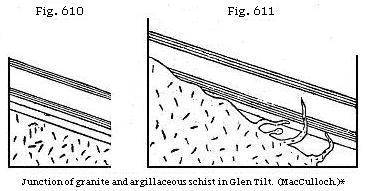
The conversion of the limestone and these and many other instances into a siliceous rock, effervescing slowly with acids, would be difficult of explanation, were it not ascertained that such limestones are always impure, containing grains of quartz, mica, or feldspar disseminated through them. The elements of these minerals, when the rock has been subjected to great heat, may have been fused, and so spread more uniformly through the whole mass.
In the Plutonic, as in the volcanic rocks, there is every gradation from a tortuous vein to the most regular form of
* Geol. Trans., First Series, vol. iii, pl. 21.
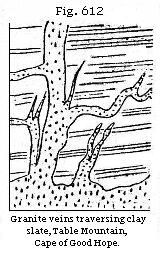
a dike, such as intersect the tuffs and lavas of Vesuvius and Etna. Dikes of granite may be seen, among other places, on the southern flank of Mount Battock, one of the Grampians, the opposite walls sometimes preserving an exact parallelism for a considerable distance. As a general rule, however, granite veins in all quarters of the globe are more sinuous in their course than those of trap. They present similar shapes at the most northern point of Scotland, and the southernmost extremity of Africa, as Figs. 612 and 613 will show.
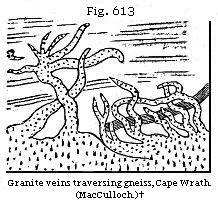
It is not uncommon for one set of granite veins to intersect another; and sometimes there are three sets, as in the environs of Heidelberg, where the granite on the banks of the river Necker is seen to consist of three varieties, differing in colour, grain, and various peculiarities of mineral composition. One of these, which is evidently the second in age, is seen to cut through an older granite; and another, still newer, traverses both the second and the first. In Shetland there are two kinds of granite. One of them, composed of hornblende, mica, feldspar, and quartz, is of a dark colour, and is seen underlying gneiss. The other is a red granite, which penetrates the dark variety everywhere in veins.‡
Fig. 614 is a sketch of a group of granite veins in Cornwall, given by Messrs. Von Oeynhausen and Von Dechen.§ The main body of the granite here is of a porphyritic appearance, with large crystals of feldspar; but in the veins it is fine-grained, and without these large crystals. The general height of the veins is from 16 to 20 feet, but some are much higher.
* Captain B. Hall, Trans. Roy. Soc. Edinburgh, vol. vii.
† Western Islands, pl. 31.
‡ MacCulloch, Syst. of Geol., vol. ii, p. 58.
§ Phil. Mag. and Annals, No. 27, New Series, March, 1829.
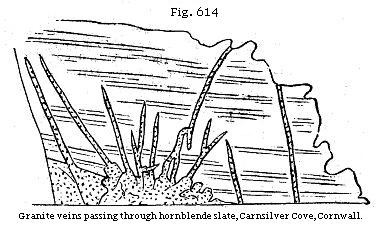
Granite, syenite, and those porphyries which have a granitiform structure, in short all Plutonic rocks, are frequently observed to contain metals, at or near their junction with stratified formations. On the other hand, the veins which traverse stratified rocks are, as a general law, more metalliferous near such junctions than in other positions. Hence it has been inferred that these metals may have been spread in a gaseous form through the fused mass, and that the contact of another rock, in a different state of temperature, or sometimes the existence of rents in other rocks in the vicinity, may have caused the sublimation of the metals.*
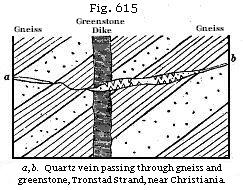
Veins of pure quartz are often found in granite as in many stratified rocks, but they are not traceable, like veins of granite or trap, to large bodies of rock of similar composition. They appear to have been cracks, into which siliceous matter was infiltered. Such segregation, as it is called, can sometimes clearly be shown to have taken place long subsequently to the original consolidation of the containing rock. Thus, for example, I observed in the gneiss of Tronstad Strand, near Drammen, in Norway, the section on the beach shown in Figure 615. It appears that the alternating strata of whitish granitiform gneiss and black hornblende-schist were
* Necker, Proceedings of the Geol. Soc., No. 26, p. 392.
first cut by a greenstone dike, about 2½ feet wide; then the crack a, b, passed through all these rocks, and was filled up with quartz. The opposite walls of the vein are in some parts incrusted with transparent crystals of quartz, the middle of the vein being filled up with common opaque white quartz.
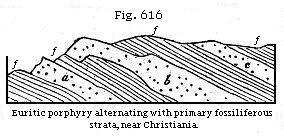
We have seen that the volcanic formations have been called overlying, because they not only penetrate others but spread over them. M. Necker has proposed to call the granites the underlying igneous rocks, and the distinction here indicated is highly characteristic. It was, indeed, supposed by some of the earlier observers that the granite of Christiania, in Norway, was intercalated in mountain masses between the primary or palĉozoic strata of that country, so as to overlie fossiliferous shale and limestone. But although the granite sends veins into these fossiliferous rocks, and is decidedly posterior in origin, its actual superposition in mass has been disproved by Professor Keilhau, whose observations on this controverted point I had opportunities, in 1837, of verifying. There are, however, on a smaller scale, certain beds of euritic porphyry, some a few feet, others many yards in thickness, which pass into granite, and deserve, perhaps, to be classed as Plutonic rather than trappean rocks, which may truly be described as interposed conformably between fossiliferous strata, as the porphyries (a, c, Fig. 616) which divide the bituminous shales and argillaceous limestones, f, f. But some of these same porphyries are partially unconformable, as b, and may lead us to suspect that the others also, notwithstanding their appearance of interstratification, have been forcibly injected. Some of the porphyritic rocks above mentioned are highly quartzose, others very feldspathic. In proportion as the masses are more voluminous, they become more granitic in their texture, less conformable, and even begin to send forth veins into contiguous strata. In a word, we have here a beautiful illustration of the intermediate gradations between volcanic and Plutonic rocks, not only in their mineralogical composition and structure, but also in their relations of position to associated formations. If the term “overlying” can in this instance be applied to a
Plutonic rock, it is only in proportion as that rock begins to acquire a trappean aspect.
It has been already hinted that the heat which in every active volcano extends downward to indefinite depths must produce simultaneously very different effects near the surface and far below it; and we can not suppose that rocks resulting from the crystallising of fused matter under a pressure of several thousand feet, much less several miles, of the earth’s crust can exactly resemble those formed at or near the surface. Hence the production at great depths of a class of rocks analogous to the volcanic, and yet differing in many particulars, might have been predicted, even had we no Plutonic formations to account for. How well these agree, both in their positive and negative characters, with the theory of their deep subterranean origin, the student will be able to judge by considering the descriptions already given.
It has, however, been objected, that if the granitic and volcanic rocks were simply different parts of one great series, we ought to find in mountain chains volcanic dikes passing upward into lava and downward into granite. But we may answer that our vertical sections are usually of small extent; and if we find in certain places a transition from trap to porous lava, and in others a passage from granite to trap, it is as much as could be expected of this evidence.
The prodigious extent of denudation which has been already demonstrated to have occurred at former periods, will reconcile the student to the belief that crystalline rocks of high antiquity, although deep in the earth’s crust when originally formed, may have become uncovered and exposed at the surface. Their actual elevation above the sea may be referred to the same causes to which we have attributed the upheaval of marine strata, even to the summits of some mountain chains.